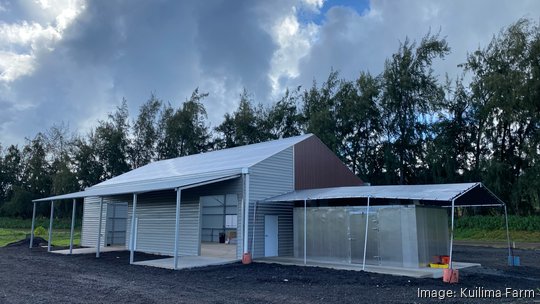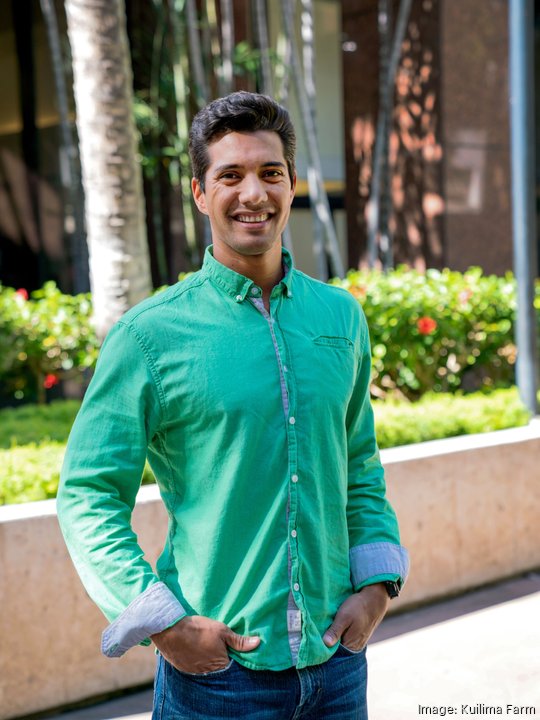
Kuilima Farm, located on Oahu’s North Shore, is working to provide local food to the island’s residents and tourists.
Owned by Turtle Bay Resort and managed by Pono Pacific Land Management LLC, the 468-acre farm supplies about 700 pounds of produce each week to the resort’s five dining establishments.
In 2016, Turtle Bay put the land into a conservation easement, meaning it can never be developed and will remain in use as agricultural land, said Ramsey Brown, the farm’s vice president of diversified agriculture. In 2019, Pono Pacific Land Management LLC came on board as the farm’s manager, he said.
According to Brown, Kuilima Farm has nine employees. The farm produces lettuce, carrots, radishes and herbs with 11 tenant farmers growing additional foods, such as eggplant, bananas, papayas, cucumbers, tomatoes, jicama, dragonfruit, avocado, citrus, and ulu, he said.

“We have the roadside farm stand off of the highway,” Brown said. “Three of those 11 farmers have kiosks at our farm stand, and they’re selling their produce. And then we’re selling our fresh lettuce and carrots and radishes and T-shirts, so people are aware of the Kuilima Farm name and logo. We also do walking tours.”
Of the 7,300 farms across Hawaii, Kuilima is one of just 100 farms currently certified under the U.S. Department of Agriculture’s food safety guidelines, according to officials with the farm.
Brown shared his thoughts with Pacific Business News on innovation, legislation and technology for Hawaii’s agriculture industry.
What are some of the trends you’re seeing in agriculture right now? There’s a lot more momentum from legislation and bills that are being talked about to support ag lands, to talk about nutrition — and not just food security, but nutrition security — and making sure that all of our families are able to eat healthy and knowing that a lot of that can come from fruits and vegetables and a lot of our fruits and vegetables can [be grown] more locally.
I think there’s a lot more awareness that most of our food is imported and people are willing to make a small buying shift to buying more local, and then — on the other side of the coin — to cooking and eating more local. When you’re buying locally, you’re buying certain things that you may not have grown up eating. Maybe you’re growing or buying more ulu, and even taro and radishes. ... I think all of that is encouraging because that allows the farmer to grow what grows well on their land ... knowing that they’re going to have an audience and a customer for it because our general population is more ready and willing to receive those items.
How does the farm use technology? We’ve got a solar-powered hydroponic greenhouse with battery backup. ... It’s a large investment in a small footprint, but it produces wonderful lettuce. It tastes good. It looks good. Because it’s in a greenhouse, there are no pests, and there are no weeds. There’s no need to spray pesticide or herbicide or anything like that. It just grows, and we just observe it. We make sure it’s getting the right nutrients. The water is on a closed loop cycle. ... According to the vendor of this hydroponic system, it uses about 80% less water than when [lettuce is] grown in the soil and and [it] grows faster. Usually, it takes about six to eight weeks [to grow lettuce], and we’re harvesting in five to six weeks.
What are some of the top challenges facing farmers in Hawaii right now? For us, it was really getting a sound business plan going with the right customers and the right mix of crops that we want to grow. We knew we wanted to be a diversified agriculture operation and ... that comes with its own challenges, as far as you can’t specialize in just one thing. So now our team has to be specialized in growing 50 different types of things and understanding what are the challenges that each one of those are going to face and so having a more diverse and complex operation is tricky.
And going back to your question, understanding the economics of that and getting it to be economically viable and sustaining it — for a new farm — is a challenge. I hear from other farmers, it’s not enough just to find a good source of water and good land and soil — which is very important for farming –but also to have a good business plan and to know how you’re going to make it and sell your product.



